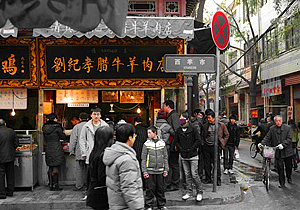Muslim Quarter

Xi'an, also known as Chang'an capital in Tang Dynasty (618–907), making the most of her initial point location of Silk Road, wide opened its door to trade the precious materials with the outside world. A diversity of races and cultures were brought in and melted and developed. Muslim merchants poured in and settled down to start their business from Tang Dynasty. To better practice their faith and life, the Muslim community grew up around the market and mosque and then nurtured the special Muslim Quarter. The strong race togetherness has enabled Muslim Quarter to survive the dynasty changes and the revolution rock and thrive with well-preserved traditions that are noticeable in the Muslim women in full dress or headscarf, strict food customs, prayer mass at mosque, etc.
The Muslim Quarter mainly consists of 4 adjacent streets: Beiyuanmen(Chinese: 北院门), Xi Yangshi (Chinese: 西羊市), Huajue Xiang (Chinese: 化觉巷), Dapi Yuan(Chinese: 大皮院). Among these streets, Beiyuanmen is the best known and easy-to-spot one zestful with the endless vendor hawk, grilled smog and the strong food aroma. This only 500-meter-long cobbled street was renovated in Tang Dynasty architecture style and on both sides is full of snack or souvenir stalls with bright-colored signs. The eye-dizzying snack variety can give a great workout to your eyes, taste buds and stomach: delicately-wrinkled juicy steamed dumplings (Chinese: 灌汤包子, Guàntāng Bāozǐ), yummy lamb sandwiches(Chinese:羊肉夹馍, Yángròu Jiāmó), sleek grilled mutton(Chinese: 烤羊肉, Káo Yángròu), crumbs in mutton broth(Chinese:羊肉泡馍, Yángròu Pàomó), stuffed persimmon cakes(Chinese: 柿子饼, Shìzǐ Bǐng), dried fruit and nuts, etc. The snack stalls are usually small and elegant restaurants also can be found here. Long queue or mass diners is the popularity sign of a stall/restaurant. Here besides the eateries, it is also a fun alternative to by wandering around to explore souvenir shops like the costumes, craft, and daily life item shops like locks, tableware and books, etc.
Actually secluded lanes and corner are where the taste surprise is always hidden and patient exploration is required. The zigzagging local-frequent Xi Yangshi and Bei Guangji Jie (Chinese: 北广济街) lanes are local-frequented and stall-clustered and harbor many authentic taste gems. These lanes have more leisurely life touch: white-skullcap stall owners chitchatting, the white-mustache senior sunbathing in the rocking chair, kids teasing the puppies, etc.
The area is also home to some Xi'an main spots like the Chinese and Islamic blend Great Mosque, the ancient official residence Gao Courtyard and Drum Tower.